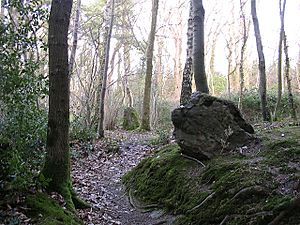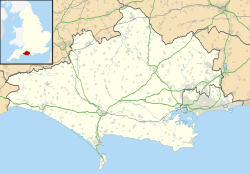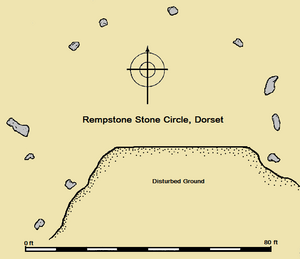Rempstone Stone Circle facts for kids

Stones from the Rempstone Stone Circle amid the woodland
|
|
| Location | Isle of Purbeck |
|---|---|
| Coordinates | 50°38′19″N 2°00′32″W / 50.6385°N 2.0089°W |
| Type | Stone circle |
| History | |
| Periods | Neolithic / Bronze Age |
The Rempstone Stone Circle is an ancient stone circle found near Corfe Castle on the Isle of Purbeck in Dorset, England. Experts believe it was built during the Bronze Age, a very long time ago. This stone circle is part of a bigger tradition of building similar circles across Britain, Ireland, and France (Brittany). This happened between 3300 and 900 BCE.
Nobody knows exactly why these circles were built. Archaeologists think they might have been special religious places. People back then might have believed the stones had magical powers. A local story says the stones landed here after being thrown at Corfe Castle by the Devil.
Many stone circles were built in the Dorset area. These circles are usually smaller than those found elsewhere. Most Dorset circles are made of a type of stone called sarsen. However, the Rempstone circle is special because it's made from local sandstone. Half of the circle is now gone. Only five standing stones and three lying-down stones remain. Clay mining in the 1700s damaged the site. Today, the circle is hidden within a thick forest. In 1957, a possible path of stones leading to the circle was found by a farmer. Sadly, these stones were later removed.
Contents
Finding the Rempstone Stone Circle
The Rempstone Stone Circle is located at a specific map point: 39940821. This old stone circle sits in a thick wood. It's just south of the B3351 road. It is about 4 kilometers (2.5 miles) east of Corfe Castle. It is also about 5 kilometers (3 miles) west of Studland.
The circle is at the bottom of Nine Barrows Down. It is about 85 meters (278 feet) above sea level. It lies about 0.5 miles south of Rempstone Lodge. Like the Nine Stones, Winterbourne Abbas, this circle is in a valley. The land where the circle sits is privately owned. It is protected by law under the Ancient Monuments and Archaeological Areas Act of 1979.
Why Were Stone Circles Built?
Between 4000 and 3000 BCE, people in Britain started building different kinds of monuments. Before this, they built long burial mounds and large enclosures. By 3000 BCE, these older structures were no longer being built. Instead, people started making circular monuments. These included earthen henges, timber circles, and stone circles.
Stone circles are found in most parts of Britain where stone is available. They are very common in south-western Britain and north-eastern Scotland. People built these circles for a very long time, from 3300 to 900 BCE. The main period of building was between 3000 and 1300 BCE.
Archaeologists have found very little evidence of people visiting these circles right after they were built. This suggests they were not used for everyday rituals. They might have been left as "silent and empty monuments." One archaeologist, Mike Parker Pearson, thought that stone was linked to the dead, while wood was linked to the living. Other experts believe the stones might have represented gods or other powerful beings.
Dorset's Stone Circles
The area of modern Dorset has only a few stone circles. There are nine possible examples known here. All of them are located within 8 kilometers (5 miles) of the sea. The Rempstone circle is the only one not on the chalk hills west of Dorchester.
Dorset's circles are quite small. None are wider than 28 meters (92 feet). They all look oval-shaped now, but they might have been round originally. The Rempstone circle is unique because it's the only one not made of sarsen stone. However, like most others, it doesn't have any extra stones or earthworks around it.
Archaeologists Stuart and Cecily Piggott believed Dorset's circles were from the Bronze Age. Aubrey Burl agreed, noting they don't match up with known Neolithic sites. It's possible they weren't all built at the same time. They might have been used into the Middle and Late Bronze Age. These circles are similar to those found on Dartmoor and Exmoor. They are also like the Stanton Drew stone circles to the north. It's also possible that these stone circles were connected to earthen henges built in Dorset around the same time.
What the Rempstone Circle Looks Like
The Rempstone Stone Circle is "damaged and overgrown," according to Aubrey Burl. Another archaeologist, John Gale, said it's "very difficult" to describe because it's "much disturbed." Eight stones are still there. Five are standing upright, and three are lying down. The standing stones are different sizes and have irregular shapes. These stones are sandstone boulders. They come from the local rock layers called the Bagshot Beds.
The southern half of the circle has been destroyed. This was likely due to clay mining in the late 1700s. In the southwest part of the site, three more stones are partly buried. These might not be in their original spots. Old clay workings have also created pools and ditches on the west side. The remaining stones form a curve. This suggests the circle was originally about 26 meters (80 feet) wide. If so, it would have been the second largest stone circle in Dorset. The largest is the Kingston Russell Stone Circle.
The archaeologist O. G. S. Crawford included the circle in his 1932 map of ancient sites. However, he accidentally gave it the wrong map coordinates. As of 2003, the site had not been dug up by archaeologists.
Other Nearby Ancient Sites
In August 1957, a farmer named W. G. Best was plowing his land. He found a row of 23 stones about 0.5 miles west of the Rempstone Stone Circle. His son stood most of these stones upright to make them easier to remove later. An expert named J. Bernard Calkin visited the site before the farmer took the stones away. Calkin noted the stones were local sandstone. They were smaller than the circle's stones, about 76 cm (2.5 feet) by 46 cm (1.5 feet). He thought they were placed in two parallel lines, 3 yards apart. There was a five-yard gap between each stone.
Calkin suggested this might have been a stone avenue or a path leading to the circle. However, Aubrey Burl later doubted this idea. About 90 feet east of the circle, there's a group of eight stones. These might have been connected to the circle in some way. There's also a group of burial mounds, called "Nine Barrows," on the hill directly south of the stone circle.
Local Stories and Legends
After the Rempstone Stone Circle was rediscovered, a local story became linked to it. This story says the stones landed in their spot after the Devil threw them at Corfe Castle. This is a common type of story. A similar legend is told about the Agglestone Rock near Studland. That story says the Devil threw the Agglestone from The Needles on the Isle of Wight. He supposedly aimed to hit Corfe Castle, or perhaps Sherborne Abbey, Bindon Abbey, or Salisbury Cathedral.



